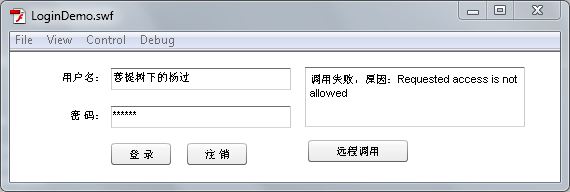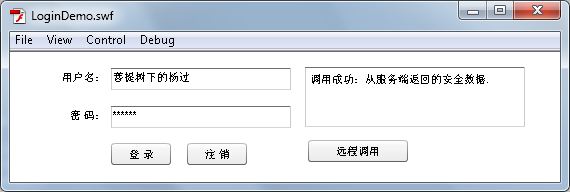对认证与授权没啥概念的新同学,建议先看下 .net中的认证(authentication)与授权(authorization),然后再继续。
Flash/Flex在通过FluorineFx调用.Net中的方法时,同样也会遇到认证与授权问题,即:
“是否随便一个阿猫阿狗都能来调用我的方法?”或者可以理解为:“调用我的方法前是否需要登录?” 这就是认证
“门卫放进来后,是不是不管什么身份的人,都能来拿东西?”或者可以理解为:“登录后的用户,具备何种资格的人才能调用方法?” 这就是授权
步骤:
1、先创建自己的LoginCommand类(相当于门卫,用于把关):DemoLoginCommand
01 | using System.Collections; |
02 | using System.Security.Principal; |
03 | using FluorineFx.Security; |
05 | namespace _04_Authentication |
07 | publicclass DemoLoginCommand:GenericLoginCommand |
09 | publicoverride IPrincipal DoAuthentication(stringusername, Hashtable credentials) |
11 | stringpassword = credentials["password"]as string; |
12 | if(username.Length > 0) |
14 | GenericIdentity identity =new GenericIdentity(username); |
16 | GenericPrincipal principal =new GenericPrincipal(identity,new string[] {"admin"}); |
2、再创建一个不需要认证就能随便调用的远程服务 DemoLoginService
02 | using System.Collections.Generic; |
07 | namespace _04_Authentication |
10 | publicclass DemoLoginService |
22 | newDemoLoginCommand().Logout(null); |
3、为了对比,再来创建一个需要认证的远程服务:DemoSecureService
02 | using System.Collections.Generic; |
07 | namespace _04_Authentication |
10 | publicclass DemoSecureService |
13 | publicstring HelloWorld() |
等一下,提个问题:比较这个服务跟刚才创建的服务,除了里面的方法名称(及相关的方法处理逻辑)不同,本质上没区别吧? 凭啥说调用这个服务就需要认证,而刚才那个服务就能随便调用?
很好,希望大家带着这个问题继续,后面会揭晓。
先打个岔:回想一下asp.net中后台目录权限的处理,我们可以在web.config 中通过配置来决定某个目录是否可访问
这段配置的意思就是 /admin目录,匿名用户无法访问(即要求登录),同时"买家","卖家"二种角色被拒绝了(即:就算你登录了,只要你是"买家"或"卖家"角色,同样也访问不了)
FluorineFx中,同样也是用配置来实现权限访问的:
先看remoting-config.xml的配置
01 | <?xmlversion="1.0"encoding="UTF-8"?> |
02 | <serviceid="remoting-service" |
03 | class="flex.messaging.services.RemotingService" |
04 | messageTypes="flex.messaging.messages.RemotingMessage"> |
08 | <adapter-definitionid="dotnet"class="FluorineFx.Remoting.RemotingAdapter"default="true"/> |
12 | <channelref="my-amf"/> |
17 | <destinationid="fluorine"> |
24 | <security-constraintref="privileged-users"/> |
29 | <destinationid="login"> |
31 | <source>_04_Authentication.DemoLoginService</source> |
关键地方已经注释了,这个配置就表明了_04_Authentication.DemoLoginService不需要登录就能调用,而其它服务调用时要受到"privileged-users"的限制,那么这个限制到底如何描述的呢?
services-config.xml配置
01 | <?xmlversion="1.0"encoding="utf-8"?> |
04 | <service-includefile-path="remoting-config.xml"/> |
10 | <security-constraintid="privileged-users"> |
12 | <auth-method>Custom</auth-method> |
18 | </security-constraint> |
20 | <login-commandclass="_04_Authentication.DemoLoginCommand"server="asp.net"/> |
24 | <channel-definitionid="my-amf"class="mx.messaging.channels.AMFChannel"> |
25 | <endpointuri="http://{server.name}:{server.port}/{context.root}/Gateway.aspx"class="flex.messaging.endpoints.AMFEndpoint"/> |
同样:重点地方已经加了注释。
另外一个重要配置:fluorineFx说到底是宿主在asp.net iis环境中的,所以它的认证票据同样是保存在cookie中的,web.config的表单认证方式要设置为Forms,即
04 | <compilationdebug="true"targetFramework="4.0"/> |
07 | <addname="FluorineGateway"type="FluorineFx.FluorineGateway, FluorineFx"/> |
11 | <authenticationmode="Forms"></authentication> |
ok,服务端就全部完成了,再来看Flash端的调用:
UI界面:

先讲下我们要做什么:
a、点击“登录”或“注销”时,调用不需要登录的DemoLoginService
b、点击"远程调用"时,调用需要认证的DemoSecureService
预测一下结果:
点击“登录”前,如果直接点击“远程调用”,应该会调用失败(因此此时尚未登录认证)
如果先点击“登录”后,再点击“远程调用”,因为这时已经登录认证过了,所以应该成功
完整flash代码:
003 | importflash.display.Sprite; |
004 | importflash.net.ObjectEncoding; |
005 | importorg.bytearray.remoting.Service; |
006 | importorg.bytearray.remoting.PendingCall; |
007 | importorg.bytearray.remoting.events.ResultEvent; |
008 | importorg.bytearray.remoting.events.FaultEvent; |
009 | importfl.controls.TextInput; |
010 | importflash.text.TextField; |
011 | importfl.controls.TextArea; |
012 | importfl.controls.Button; |
013 | importflash.events.MouseEvent; |
017 | publicclass LoginDemo extendsSprite |
019 | privatevar _txtUserName:TextInput; |
020 | privatevar _txtPassWord:TextInput; |
021 | privatevar _txtResult:TextArea; |
022 | privatevar _btnLogin:Button; |
023 | privatevar _btnLogOut:Button; |
024 | privatevar _btnCall:Button; |
026 | privatevar _gatewayUrl:String= ""; |
027 | privatevar _service:Service; |
028 | privatevar _callService:Service; |
029 | privatevar _rpc:PendingCall; |
032 | publicfunction LoginDemo() |
035 | this._txtUserName = txtUserName; |
036 | this._txtPassWord = txtPassword; |
037 | this._txtResult = txtResult; |
038 | this._btnCall = btnCall; |
039 | this._btnLogin = btnLogin; |
040 | this._btnLogOut = btnLogout; |
042 | this._txtUserName.text ="菩提树下的杨过"; |
043 | this._txtPassWord.displayAsPassword =true; |
044 | this._txtPassWord.text ="123456"; |
047 | if(root.loaderInfo.parameters.remotingGatewayPath != null) |
049 | _gatewayUrl = root.loaderInfo.parameters.remotingGatewayPath +"/Gateway.aspx"; |
058 | this._btnLogin.addEventListener(MouseEvent.CLICK,btnLogin_Click); |
059 | this._btnLogOut.addEventListener(MouseEvent.CLICK,btnLogout_Click); |
060 | this._btnCall.addEventListener(MouseEvent.CLICK,btnCall_Click); |
066 | privatefunction btnLogin_Click(e:MouseEvent):void |
068 | _service =new Service("_04_Authentication.DemoLoginService",_gatewayUrl,ObjectEncoding.AMF3); |
070 | _service.setRemoteCredentials(this._txtUserName.text,this._txtPassWord.text); |
071 | _rpc = _service.Login(); |
072 | _rpc.addEventListener( ResultEvent.RESULT, loginSuccess ); |
073 | _rpc.addEventListener( FaultEvent.FAULT, loginFailure ); |
077 | privatefunction loginSuccess( pEvt:ResultEvent ):void |
079 | this._txtResult.text ="登录成功!"; |
084 | privatefunction loginFailure( pEvt:FaultEvent ):void |
086 | this._txtResult.text ="登录失败,原因:" + pEvt.fault.description; |
090 | privatefunction btnLogout_Click(e:MouseEvent):void |
092 | _service =new Service("_04_Authentication.DemoLoginService",_gatewayUrl,ObjectEncoding.AMF3); |
093 | _rpc = _service.Logout(); |
094 | _rpc.addEventListener( ResultEvent.RESULT, logoutSuccess ); |
095 | _rpc.addEventListener( FaultEvent.FAULT, logoutFailure ); |
100 | privatefunction logoutSuccess( pEvt:ResultEvent ):void |
102 | this._txtResult.text ="注销成功!"; |
107 | privatefunction logoutFailure( pEvt:FaultEvent ):void |
109 | this._txtResult.text ="注销失败,原因:" + pEvt.fault.description; |
113 | privatefunction btnCall_Click(e:MouseEvent):void |
115 | _callService =new Service("_04_Authentication.DemoSecureService",_gatewayUrl,ObjectEncoding.AMF3); |
116 | _rpc = _callService.HelloWorld(); |
117 | _rpc.addEventListener( ResultEvent.RESULT, callSuccess ); |
118 | _rpc.addEventListener( FaultEvent.FAULT, callFailure ); |
123 | privatefunction callSuccess( pEvt:ResultEvent ):void |
125 | this._txtResult.text ="调用成功:" + pEvt.result; |
130 | privatefunction callFailure( pEvt:FaultEvent ):void |
132 | this._txtResult.text ="调用失败,原因:" + pEvt.fault.description; |
测试运行的截图:

这是一上来就直接点击"远程调用"的结果,注意右侧的大文本框:Requested access is not allowed 即访问不允许,说明这个服务是需要认证才能调用的。

如果点击“登录”后,再点击"远程调用",这回成功了,说明认证起作用了。
最后再啰嗦一下:前面提到了FluorineFx的认证票据跟asp.net一样,是保存在Cookie的,所以如果您把swf嵌入到网页上,在flash中点击登录后,如果在其它aspx页面上用
01 | <% if(!User.Identity.IsAuthenticated) |
03 | Response.Write("<h5>尚未登录!</h5>"); |
07 | Response.Write("<h5><span style='color:red'>"+ User.Identity.Name + "</span>已经登录!</h5>"); |
同样也能检测出用户的登录状态!(前提是不要关闭刚才那个嵌入swf的页面)
唯一遗憾的是:FluorineFx生成的Cookie认证票据中,并未包含Roles角色信息,所以在AspX页面上无法用IsInRole来判断当前用户的角色(我跟踪了一下,fluorineFx在Cookie中仅保存了用户名、密码以及一些唯一性标识,官方提供的认证演示中虽然有用IsInRole来判断,但其实是没用的)。
当然这个问题,您可以修改FluorineFx的源码来解决,这点工作就留给大家了。
不过令人高兴的是,反过来却可以!即:如果在asp.net上登录了,认证和授权信息在flash里能识别,通常情况下,这已经能满足绝大多数需要了。
示例源代码下载: http://cid-2959920b8267aaca.office.live.com/self.aspx/Flash/FluorineFx^_Demo^_04.rar













 本文详细介绍了 FluorineFx 中的认证与授权机制,通过创建 LoginCommand 类实现用户认证,以及通过配置文件设定服务的访问权限。演示了如何在 Flash 端实现登录、注销及调用需要认证的服务的功能。
本文详细介绍了 FluorineFx 中的认证与授权机制,通过创建 LoginCommand 类实现用户认证,以及通过配置文件设定服务的访问权限。演示了如何在 Flash 端实现登录、注销及调用需要认证的服务的功能。
















 211
211

 被折叠的 条评论
为什么被折叠?
被折叠的 条评论
为什么被折叠?








